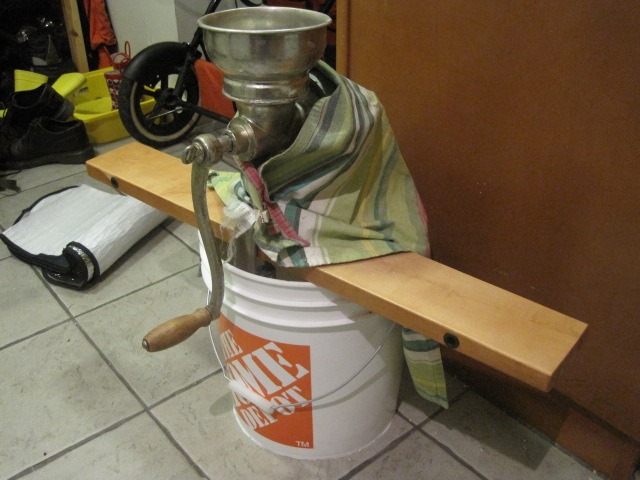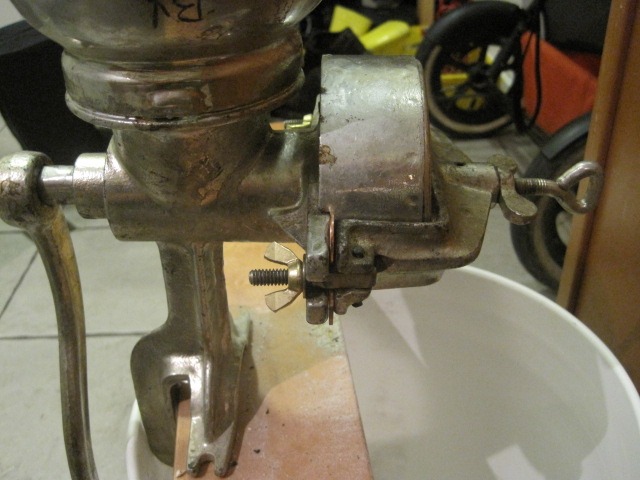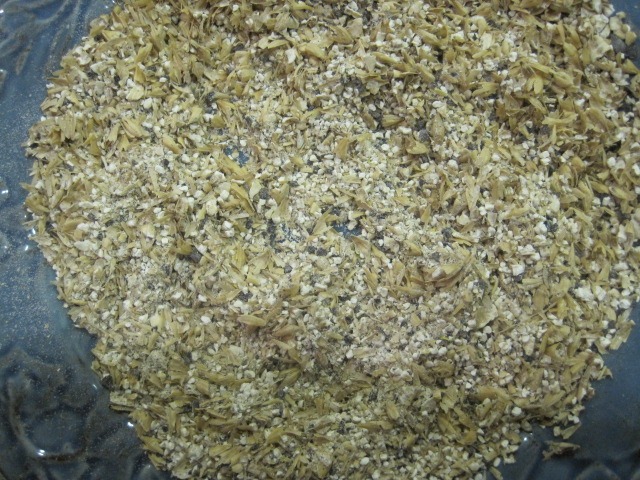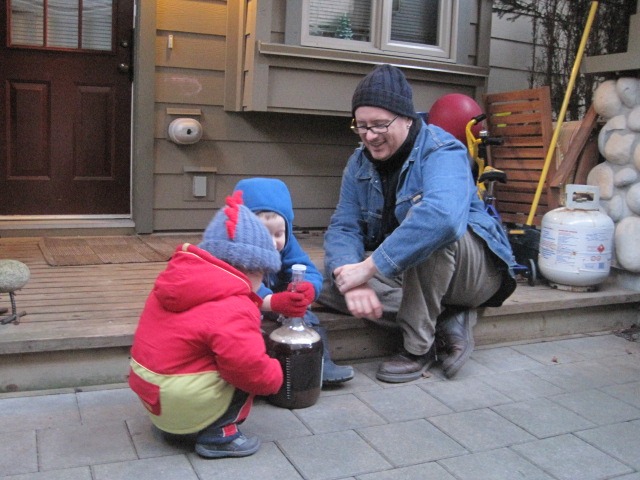Bropsa Bripsa Soured Stout
I found myself thinking about Guinness and how it's supposedly made
with 3% soured beer...so why not a sour mash stout at home? And since
this was the first time using the grain mill, I figured I'd make it a
one gallon batch. (Oh, and the fact that I don't know what a soured
stout will taste like. 
(Ha! Turns out I'm not the only one who's thought of a soured stout.)
Recipe
Ingredients:
- 2 lb Gambrinus ESB
- 3 oz barley flakes
- 3 oz roasted barley
- 1.5 oz Gambrinus ESB soured (or about 5% of the base grain by weight)
Hops:
- 0.5 oz Northern Brewer (7.8%) @ 60 minutes
Yeast:
- Harvested Wyeast 1056 (American Ale)
Prep
December 3, 2009: The sour mash was prepared by heating up some water -- not much; at 1.5qt/lb, it was about 125 ml or so (I've got to switch entirely to metric some day) -- and dumping it in a bowl to watch the temperature. I was aiming at 50C (120F); when it got to 60C I called it good and dumped in the grain, then dumped it all in an unheated thermos. I didn't have a thermometer long enough to fit in the thermos, so I had to assume that there would be a 10C drop in temperature as it went it. I covered it with saran wrap and left it. (Instructions for sour mashing gratefully taken from Basic Brewing.)
As for the starter, I had some Wyeast 1056 I'd washed back in July from the Tandoori IPA. I made up some wort with 1/4 cup (60 ml...see?) of liquid malt extract and 450 ml (2 cups) of water; I didn't check the gravity or do calculation because that's how I roll, but it should be around 1.040.
I cooled it down, sanitized a handy mason jar, and poured it in. The yeast came out of the refrigerator and did not warm up very much before I pitched it -- my bad. I poured off most of the beer (which smelled just like the IPA...mmmm), shook up the rest, poured it in and shook it again. I used some designated-sanitized foil (ie, I didn't touch the middle so it must be okay) to cover it.
Grain was ground with the Value Village score:

I didn't have any washers, so I used pennies to keep the spacing right:

A few test runs, and I think the crush was okay (though still a lot of flour):

Brew Day
December 3, 2009: The great thing about a small batch is that heating and cooling takes such little time. 1.5 gallons of water to a boil? 30 minutes. Chilling the wort? 20 minutes of ice water in the sink. Sweet!
Now the bad news: the starter didn't seem to do much, even after two days. I'd heard that with small starters it can be easy to miss the activity, and it still smelled like yeast, so I decided to go with it.
Mashing was also kind of difficult; the small thermal mass meant that, even while wrapping the pot in an insulated windshield shade, the temp dropped from 154F/68C to 135F/57C. I added a bit of boiling water and kept going. Total mash time was about an hour and twenty minutes, and the volume was 6 quarts/6 litres.
Again, no firm volumes, but based on my usual absorption it would have been almost 5 quarts. Gravity was 1.045, which'd put efficiency at around 75 - 80%. Not bad for the first time with the Corona mill!
After the boil, volume was just under a gallon and gravity was 1.065 -- wow; not what I was after. The evaporation rate I'd assumed was 10%, which is what I usually get in 5 gallon batches; 5.5 in the pot, 5 in the fermenter. However, this time it was 33% -- or 0.5 gallons, same as in the 5 gallon batches. I'm starting to think that the half-gallon/hour is a better estimate.
(Digression: If that's the case, I should have aimed at 1.030 to 1.035 or so. That'd mean lowering the base malt to, say, 1.5 pounds or so.)
The colour was also a bit lighter than I was aiming for: a medium-dark brown rather than inky black.
However! The kids liked the look of things:

Fermentation
Temp started at 14C, then swung down below 13C. No obvious activity 'til Dewcember 7th, and overall it was quite slow in its trajectory -- strongest on December 10th, rather than (say) 48 hours after pitching. Not sure if this was due to cold temperatures or reviving the starter from the fridge.
Bottling day
December 27, 2009: Moved this out from cold (14C or so) to warm (well, 18C) 24 hours in advance (so, the 26th) as a sort of diacetyl rest. No idea if it actually needed it...
Final gravity was 1.014, so about 6.8% ABV. Darker than I thought it would come out. The small sample I had tasted quite nice -- much closer to a stout than I expected. Looking forward to trying this. Oh, and 20g dextrose for priming, 7 Grolsch bottles yield.
Tasting
January 5, 2010: Could not wait, and oh wow, did this turn out well. It's still a bit green, but it's very, very nice. Smooth taste -- no harshness from the alcohol at all. Dark, dark brown, almost black. This is going to be good. Oh...no sour flavour at all. Oh well.
January 12, 2010: Still very good, still no sourness. Very, very, very smooth; I could drink this all day.